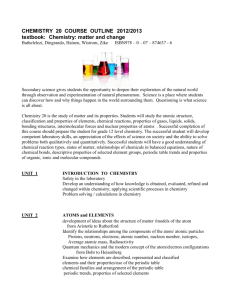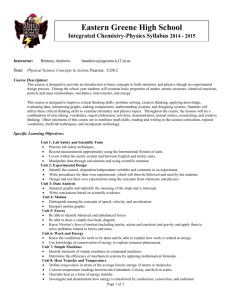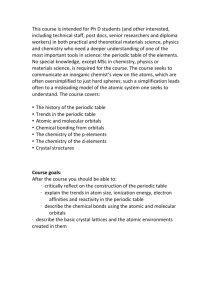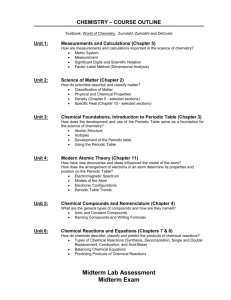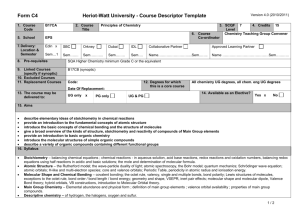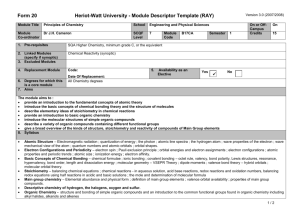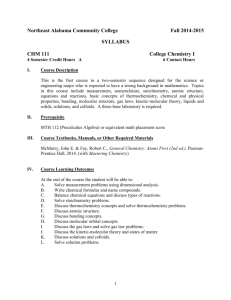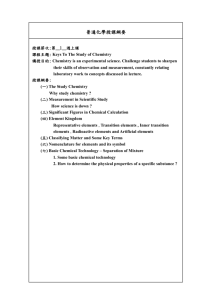CH091 - Mohawk Valley Community College
advertisement
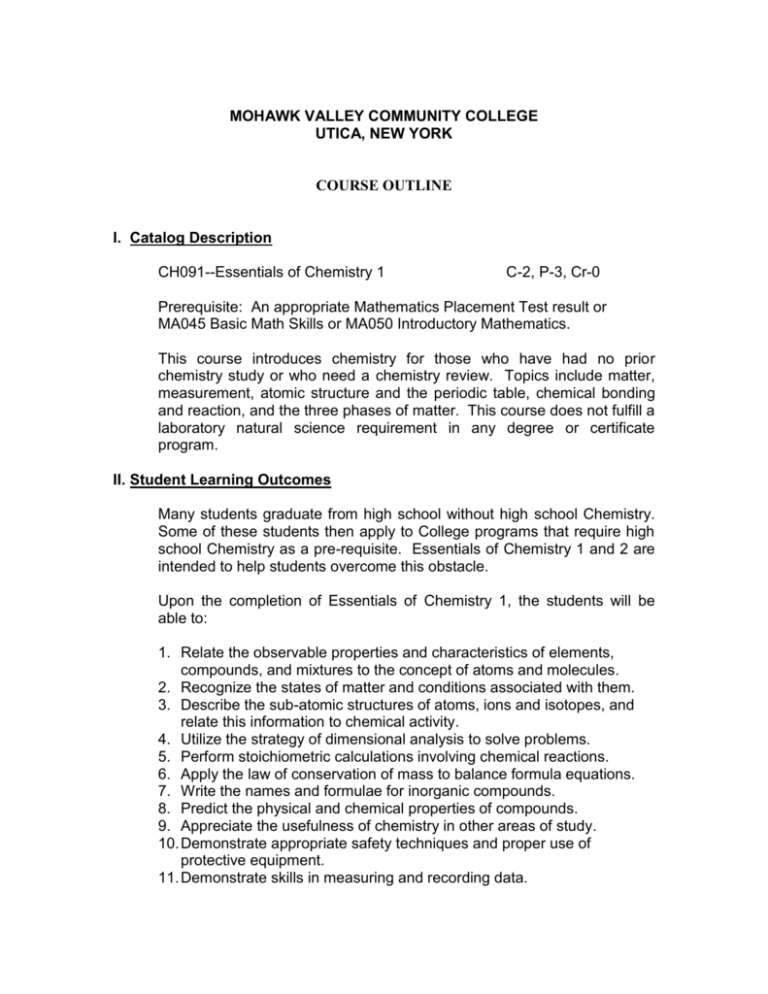
MOHAWK VALLEY COMMUNITY COLLEGE UTICA, NEW YORK COURSE OUTLINE I. Catalog Description CH091--Essentials of Chemistry 1 C-2, P-3, Cr-0 Prerequisite: An appropriate Mathematics Placement Test result or MA045 Basic Math Skills or MA050 Introductory Mathematics. This course introduces chemistry for those who have had no prior chemistry study or who need a chemistry review. Topics include matter, measurement, atomic structure and the periodic table, chemical bonding and reaction, and the three phases of matter. This course does not fulfill a laboratory natural science requirement in any degree or certificate program. II. Student Learning Outcomes Many students graduate from high school without high school Chemistry. Some of these students then apply to College programs that require high school Chemistry as a pre-requisite. Essentials of Chemistry 1 and 2 are intended to help students overcome this obstacle. Upon the completion of Essentials of Chemistry 1, the students will be able to: 1. Relate the observable properties and characteristics of elements, compounds, and mixtures to the concept of atoms and molecules. 2. Recognize the states of matter and conditions associated with them. 3. Describe the sub-atomic structures of atoms, ions and isotopes, and relate this information to chemical activity. 4. Utilize the strategy of dimensional analysis to solve problems. 5. Perform stoichiometric calculations involving chemical reactions. 6. Apply the law of conservation of mass to balance formula equations. 7. Write the names and formulae for inorganic compounds. 8. Predict the physical and chemical properties of compounds. 9. Appreciate the usefulness of chemistry in other areas of study. 10. Demonstrate appropriate safety techniques and proper use of protective equipment. 11. Demonstrate skills in measuring and recording data. -2- III. Main Topics 1. Matter and Measurement a. Elements - Compounds – Mixtures (i) Symbols of Elements in Chemical Formulas b. Measurements in Chemistry c. Metric system d. Density e. Dimensional Analysis f. Unit Conversions g. Properties of Matter h. Changes in Matter i. Energy j. Heat 2. Atomic Structure and the Periodic Tables a. b. c. d. e. f. Dalton's Atomic Theory Nuclear Atom Bohr Model Electron Configuration Periodic Table Elements (i) Isotopes (ii) Atomic Number (iii) Mass Number 3. Nomenclature a. Ionic Compounds b. Molecular Compounds 4. Chemical Equations a. b. c. d. e. f. Balancing Chemical Equation (The Law of Conservation of Mass) Types of Chemical Reactions The Mole and Avogadro's Law Molecular and Formula Masses Molecular formula Stoichiometry (i) Mole Ratios (ii) Mass-Mass Calculations -35. Chemical Bonds a. Lewis Structure (Electron Dot) b. Ionic Bonding c. Covalent Bonding (i) electronegativity (ii) bond polarity d. Lewis Formulas - Octet Rule e. Polyatomic Ions 6. Gases a. b. c. d. e. f. g. h. i. j. Kinetic Molecular Theory Boyle's Law Charles' Law Molar Volume of a Gas (Avogadro's Law) Combined Gas Law Ideal Gas Law Henry's Law Dalton's Law of Partial Pressures Density of Gases Stoichiometry in the Gas Phase ESSENTIALS OF CHEMISTRY I PRACTICUM SCHEDULE MAY INCLUDE BUT NOT BE LIMITED TO THE FOLLOWING TOPICS Week 1 2 3 4 5 6 7 8 9 10 11 12 13 14 Whole Numbers and Decimals Signed Numbers Powers of Ten Logarithms Measurement Concepts and Dimensional Analysis Metric System Density and SG The Division and Properties of Matter Atomic Structure Chemical Bonding and Formula Writing Naming Compounds Balancing Chemical Equations Weight Relations in Chemistry Chemical Equations and Stoichiometry The Gas Laws REVIEW -4ESSENTIALS OF CHEMISTRY I LABORATORY SCHEDULE Week 1 2 3 4 5 6 7 8 9 10 11 12 13 14 15 Feb. 2011 Check-in and Safety Lab Techniques Measurements Preparation and Properties of O2 Freezing Point Graphing Periodic Table Calorimetry and Specific Heat Water in Hydrates Composition of Potassium Chlorate Single Displacement Rx Double Displacement Rx Quantitative Preparation of Potassium Chloride Boyle's Law Charles’ Law Check-out
